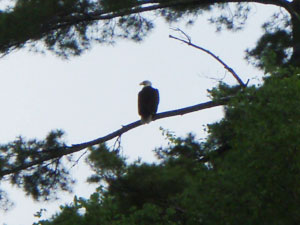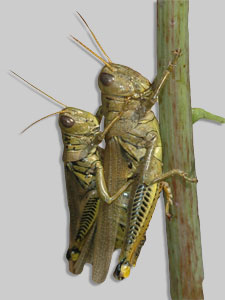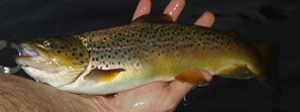

September, 2008
Design
 Any fly-fisher, properly provoked, will expound ad nauseum on why one fly pattern is superior to others. He will use words like size, shape, color, silhouette, refraction, translucency, castability, and a host of others. Our fisherman is referring to the design of the fly. All the great patterns are highly successful at one profoundly simple thing; they catch fish - lots of fish. This success is not by accident. These flies are conceptualized and executed with great care and forethought. Then (and this is the fun part!) the patterns are tested, modified, and retested. Sort of a literate way of saying “ I’m going fishing, won’t be back for a while.”
Any fly-fisher, properly provoked, will expound ad nauseum on why one fly pattern is superior to others. He will use words like size, shape, color, silhouette, refraction, translucency, castability, and a host of others. Our fisherman is referring to the design of the fly. All the great patterns are highly successful at one profoundly simple thing; they catch fish - lots of fish. This success is not by accident. These flies are conceptualized and executed with great care and forethought. Then (and this is the fun part!) the patterns are tested, modified, and retested. Sort of a literate way of saying “ I’m going fishing, won’t be back for a while.”
Buyer beware. Oodles of fly patterns are designed to catch fishermen, not fish. Many a great hat decorator has been marketed as the next Muddler Minnow. In addition most of the commercially sold flies are not tied by folks who wield fly rods. Rather, they are tied overseas by people who have never heard of tailing loops, breathable waders, or spinner falls. While many are very talented tyers, they tie their flies according to the instructions of others rather than personal observation and experimentation.
A great example of this lies with the venerable Clouser’s Deep Minnow. This innovative and effective fly was designed to be tied with a sparse and unstacked (uneven) hair wing, resulting in a fly that looks like it was tied by a second grader. Almost all foreign tied Clousers I’ve seen have a nice, thick, even wing; everything is “nip and tuck” resulting in a nice looking fly that catches fewer fish. The fly loses its translucency and taper, a far cry from the original and highly effective design.
My original fly patterns are the product of many hours of designing, tying, testing, modifying, retesting, etc… Then I give samples to friends, guides, and assorted fly fishers to try out on waters and fish of their choosing. I’ve designed some dogs but for the most part the results have been very encouraging. The most successful of my patterns are available on this website. The real dogs are used for casting practice, the pretty poodles are for hat decorations.
The case of the single winged mayfly
I can’t count how many times I’ve heard the question “Why do your mayfly duns have a single undivided wing?” This question comes from novices and fly shop owners alike. The answer is profoundly simple: Real mayfly duns (subimagos) rest on the water’s surface with their wings upright and together above their body. They appear to only have a single wing until they take flight. Most standard dry flies that are made to imitate mayfly duns have their wings divided so the fly has two distinct wings when viewed on the stream (please note that I am not referring to spent wing spinners whose wings are 180 degrees from each other held out to the flies’ lateral sides). Simply stated the wings on my duns appear more like the bug that they are designed to imitate. In addition, the materials on many common commercial patterns, are made of soft, webby materials like wood duck flank, hackle tips, or the like. After a good soaking these materials absorb water and fish slime like than a sponge, definitely not the ideal case for a dry fly. I use water repellant synthetic post material (sometimes mixed with a little polypropylene yarn which also floats like a cork) for my mayfly duns. Thus the fly looks more natural and floats better resulting in less time drying and treating the fly and more time fishing. It’s a simple modification of a design element that greatly enhances the flies’ performance.
Materials
All of the flies I tie are tied with the highest quality materials. I don’t believe in saving a few bucks buy purchasing inferior materials. The bulk of my materials come from Spirit River, Hareline Dubbin, Whitetail Tying Supplies, and Whiting Farms. All are distributors of the highest repute. From the hook to the hackle superior materials enhance a flies performance and durability. We’ve all seen the Marabou Mickey Finn that a buddy purchased for a buck and a quarter turn a nice shade of orange after being in the water for five minutes. You won’t find that here.
Construction
When fishing with some friends recently I was using a large streamer with limited success while my friend in the back of the boat was getting a lot of strikes on a dry Stimulator pattern. We anchored near a nice hole and the Stimulator fisherman was getting strikes on almost every cast. For some odd reason, despite being a seasoned dry fly fisherman, he was missing all of his strikes. Finally, I asked to look at his Stimulator and lo and behold the wing had rotated around the hook shank rendering the fly weedless and fishless. The fly would simply bounce away from the trout because the hook point was covered with what used to be the elk hair wing. I diplomatically inquired where he had purchased this loosely tied bug. Somewhat embarrassed, he confessed that he had got a great deal at a local “big box” outdoors store. The fly certainly attracted its share of trout but became useless after being cast a few times. Some deal.
 Even the World’s greatest fly patterns are junk if not properly tied. Did the tyer pay attention to details or try to make his three dozen flies per hour quota? I think the answer in the case of the Stimulator with the rotating wing is quite clear. All of my flies are tied over a full thread base, a detail that takes time and also makes the fly much more durable. All heads are whip finished and most are also cemented. I use time tested tying methods that take longer to tie but result in a fly whose construction is far superior to the mass produced flies from far away lands. Superior tying techniques greatly improve the durability of the fly which translates into a far better “deal” than you can get from any inexpensive fly. Let’s face it – quality takes time.
Even the World’s greatest fly patterns are junk if not properly tied. Did the tyer pay attention to details or try to make his three dozen flies per hour quota? I think the answer in the case of the Stimulator with the rotating wing is quite clear. All of my flies are tied over a full thread base, a detail that takes time and also makes the fly much more durable. All heads are whip finished and most are also cemented. I use time tested tying methods that take longer to tie but result in a fly whose construction is far superior to the mass produced flies from far away lands. Superior tying techniques greatly improve the durability of the fly which translates into a far better “deal” than you can get from any inexpensive fly. Let’s face it – quality takes time.
October, 2008
The hook is indeed the backbone of a fly. The uncelebrated hook is the final connection between the angler and the fish. The greatest fly pattern isn’t so great unless its tied on a high quality hook. If you think that I'm being overly dramatic - read on...
 A number of years ago a good friend and I were Steelhead fishing on Michigan's White River. We were both pretty new at Steelhead fishing but on this particular day the fish didn't know that. It turned out to be one of those magical days that all Steelhead anglers dream about. The fish were plentiful and more than eager to take a fly. Somehow I managed to, literally, stumble into a group of very active fish. Almost immediately I hooked a very large fish. The beast broke the surface, looked at me, and took off. I set the hook and the fun was over.
A number of years ago a good friend and I were Steelhead fishing on Michigan's White River. We were both pretty new at Steelhead fishing but on this particular day the fish didn't know that. It turned out to be one of those magical days that all Steelhead anglers dream about. The fish were plentiful and more than eager to take a fly. Somehow I managed to, literally, stumble into a group of very active fish. Almost immediately I hooked a very large fish. The beast broke the surface, looked at me, and took off. I set the hook and the fun was over.
"Wow," I think,"that was very cool, let's try again."
The next 10 casts hooked half a dozen fish, each was a solid strike followed by slack line. I’m becoming more frustrated with each successive cast until I'm finally jumping up and down in the river spewing colorful language like a blue comedian. Meanwhile, my friend, and others, were laughing at the hapless, wader clad screaming lunatic who was attempting to walk on water. I earned the nickname "Ahab" that day, thankfully it didn't stick, at least not that I know of.
After I calmed down, the fish scattered, and the laughter subsided I had the presence of mind to examine my amber stone nymph that the Steelhead seemed to love then immediately spit out. Eureka! The hook was straight as an arrow. Its pretty tough to land a fish on a straight hook!
Following that fateful day I've switched all of my fly hooks to premium quality hooks. Since then I've landed countless large fish and have never had another hook failure. The extra pennies spent are well worth it. All of the flies available on this site are tied on Daiichi or Tiemco hooks. Both of these companies produce some of the highest quality hooks available today.
Barbless hooks
All of the flies in this site with the exception of Salmon and Steelhead flies are tied on barbless or debarbed hooks. I also strongly encourage anglers in pursuit of Salmon and Steelhead to de-barb their hooks. Why barbless?
First, and most obvious, releasing fish is a breeze with a barbless hook. Simply grab the head of the fly, twist and back out the hook at the same time and the fish goes free quickly and unharmed. Often the fish can be released without unnecessary handling which can interrupt its slime coating that functions to ward off infection and disease. The wound left in the mouth of the fish is much smaller when using a barbless hook versus a barbed hook. There is simply no barb to tear extra flesh from the fish when the hook is backed out.
Second, you will not lose significantly more fish from the absence of a hook barb. Most lost fish are due to poor hook set technique as well as not keeping tension on the line during a spirited struggle between angler and fish. As illustrated above, the hook's bend, not its barb, keep the angler connected with the fish. In fact, barbless hooks penetrate faster and deeper than their barbed counterparts because there is less cross-sectional area in the hook point region due to the absence of the barb.
Third, the hooks I use to tie the flies listed on this site are extremely sharp, and penetrate very fast, especially the Daiichi X-Points and the Tiemco Super Points. Should a mishap occur, and they do when you least expect it, these hooks are much easier to remove from human flesh. In most cases a barbless hook can be backed out rather than the conventional technique of pushing the hook all the way through, cutting the point off and then backing the remaining portion out of the wound. I've seen an X- Point hook enter, and exit, someone's finger so quickly that the individual didn't know that he had been hooked. Fortunately, the hook was debarbed and we just backed it out and treated the wound accordingly. He lived to fight another day.
November, 2008.
Streamer fishing is the antithesis of traditional fly-fishing. An unmended line belly is desirable, the angler constantly moves the fly, the fly hits the water with a resounding “splat,” and full sink lines are the norm. What sounds like a gentle fly-fisher’s nightmare is an extremely effective method for catching trout, especially big dogs. What follows is a quick and dirty introduction to streamer fishing – the way I fish them, from a drift boat on a large (by Michigan standards) river.
When most people think of streamer fishing the drift/swing method quickly comes to mind. I advocate the jerk/strip method which constantly moves the fly and moves it quickly. For more details read Bob Linsenman and Kelly Galloup’s excellent book Modern Streamers for Trophy Trout ( ISBN 0-88150-466-1). Everyone who schedules a guided trip with me should study the following paragraphs in order to gain the maximum benefit ( i.e. have the most fun!) from their trip.
 There are three simple rules to streamer fishing:
There are three simple rules to streamer fishing:
Sounds simple, doesn’t it?
Presentation and Casting
As streamer flies are somewhat large, I like #2’s and larger, delicacy during fly presentation is not an issue. Rather, you want the fly to land hard on the water, then immediately begin your retrieve. Do not confuse casting presentation with casting accuracy. Accuracy and distance are extremely important in streamer fishing. A nice tight loop is essential for delivering large flies the distance required for drift boat streamer fishing. This is not small stream fishing where a 30' cast will put your fly over that logjam you were aiming for and into the trees.
Of course hand-in-hand with tight loops is high line speed. Achieving high line speed is not accomplished by waving the rod around like a baseball bat, bullwhip or some other implement of death and destruction. Proper casting technique is required here. Let the rod do the work, not your casting arm. You paid a lot of money for that nice pretty piece of graphite, make it earn its keep! A 60 foot cast with a fast action 6-weight fly rod should be nearly effortless.
It is important to practice your fly casting before a trip. If you don’t have ready access to a pond or stream, a stroll to the local park or your back yard are great solutions. Practice by throwing the tightest loops you can at a comfortable distance. Then try throwing some longer casts and pay attention to those loops! Watch your back cast as the old saying “80% of your problems are behind you” is 100% true in fly casting.
Stick to this regimen a couple of times a week for a few weeks. Not only will it improve your casting, it will improve your strength and endurance. Streamer fishing is hard work that requires fast retrieves, a large number of casts, and long casts. Any improvement to your endurance will make for a much less exhausting trip, plus it will increase your chances of catching more fish!
The Retrieve
A proper retrieve is critical to successful streamer fishing. Remember; fast and downstream. With the rod tip close to the water (some guides advocate putting the tip under the water’s surface) jerk the rod tip in the direction of your retrieve. Then bring the tip back to its starting point while stripping in the slack line. Repeat. Repeat it faster. A small jerk on the rod tip is all that’s required. Most novices at this kind of fishing move the fly much too slowly, its useful to remember that a fish can swim much faster than you can retrieve a fly. Did I mention that you have to do this quickly?
Panicked, fleeing baitfish usually swim in a downstream direction which is exactly what we want our streamer flies to do. When casting from a drift boat achieving this movement is simple. Cast across the current and allow a slight belly to form in the line. As you retrieve, the fly will swim downstream as the boat is also drifting downstream. Also, did I mention that you have to do this quickly?
So why all this need for speed? When streamer fishing you want to provoke a territorial response from the fish. Given too much time the trout will simply laugh (or whatever trout do) at your big gaudy fly and go about its daily business. However if a large fly rapidly passes through a trout’s cone of vision and the fly keeps moving it will often provoke an aggressive response from large trout. Whether this response is caused by anger, territorialism, instinct, or opportunistic feeding (“Hey there’s a porterhouse steak swimming by – I think I’ll eat it!”) I don’t know. What I do know is that you will never forget a 24” brown chasing your streamer with its mouth wide open! You will also remember the ensuing strike and the mayhem that follows…